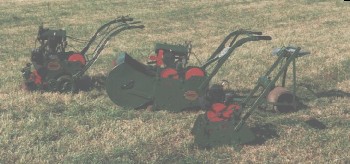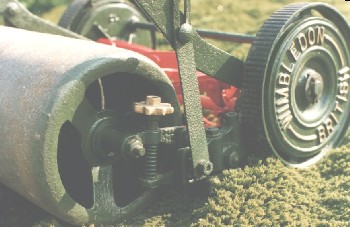
Many regional companies were producing their own machines, one being Automower of Norton St Phillip, nr Bath, Somerset. George Grist first entered the market in the early 1920s by adding an engine unit to Ransomes & Green's pony mowers. By 1925 Automower were producing their own steel-constructed models which were to become a great success with owners of large country houses. Automower were to design the AutoRoller synonymous to all groundsmen to this very day.

The Royal Horticultural Society conducted motor mower trials in May 1925 in Regent's Park, London, with 25 machines from different makers present. Ransomes entered an M.P. mower pusher pulling a Ransomes gang unit capable of cutting 6in high grass. Awards of Merit went to Green, Shanks and Dennis in the 30in to 42in range. The Atco, Automower, M.P. mower pusher and Rendle's motor mower attachments were highly commended. Godiva Engineering and F Mitchell from Nottingham (under licence from J.P.) were also commended. These R.H.S. trials certainly put the seal of approval on motor mowers.
A new development in motive power came in 1926 when Ransomes introduced their electrically-powered 16in mower, sold complete with 50 yards of flex. Ransomes were well-advanced with electrical propulsion in general, having produced their first commercial electric lorry in 1901.

By the end of the 1920s most companies were designing mowers using steel because it was becoming cheaper and the need for greater strength was growing. In 1929 Greens added the Prince to their range of hand mowers. This machine was of a total steel construction except the handles which were of malleable iron.
In 1930 Atco had gained their Royal Warrant along with other such names as Ransomes, Shanks, Green and Dennis. The depression years of 1931 and 1932 saw many people out of work. Undeterred, Atco introduced a totally new range of steel-constructed mowers.
The 1930s saw a new market open for the lawn mower. The middle classes of this country were becoming first-time buyers of houses with small gardens and small lawns. To fulfil the need Ransomes developed the Midget 14in cut cylinder motor mower. The 1930s also saw Ransomes become one of the largest lawn mower producers in the world.
In 1933 came the most radical development in lawn mower design since Budding's first patent. This was the rotary mower developed by Power Specialities of Slough, Berkshire. The idea was to cut the grass in a rotary action at speed by use of an engine. The blade had a hood over the top so that, as it turned, it created a vacuum allowing the cut grass to be lifted into a grass collector behind. The engine was of a two-stroke variety as it had to operate at different angles.
The design was at first shunned by the profession, possibly because the marketing idea was aimed at the domestic user. It was, however, quickly realised that the mower could make a good job on short grass as well as long. The machine came in many different sizes; the 10in to 13in models were electrically-powered while 15in to 18in were powered by a petrol engine. By 1936 Power Specialities had introduced fluid transmission into the range. In 1937 the 15in and 18in models were renamed Eton and Windsor respectively.

In 1935 Greens finally withdrew the Silens Messor from production although it could still be purchased new after the Second World War. By the late 1930s Qualcast had overtaken Follows & Bates in the push mower market and, as the clouds of war once again loomed over Britain, normal production of lawn mowers ended.
Those companies involved with production of gang mowers were allowed to continue making spare parts alongside their munitions work for gang mowers were still needed for the cutting of aircraft runways.
In February 1940 a very sympathetic government introduced petrol rationing for lawn mowers with coupons being obtainable from local Post Offices, after filling in a RMS5 form.